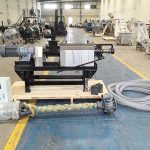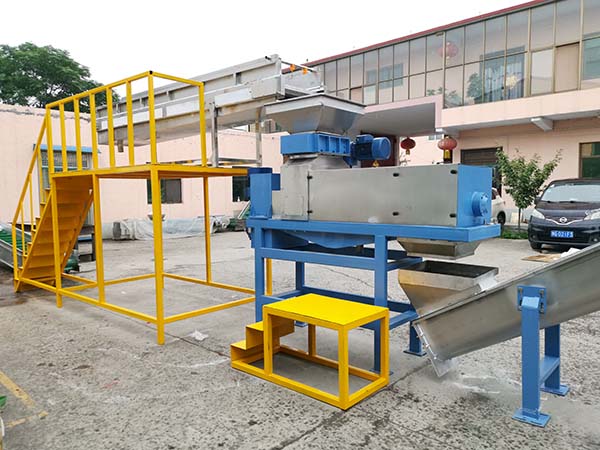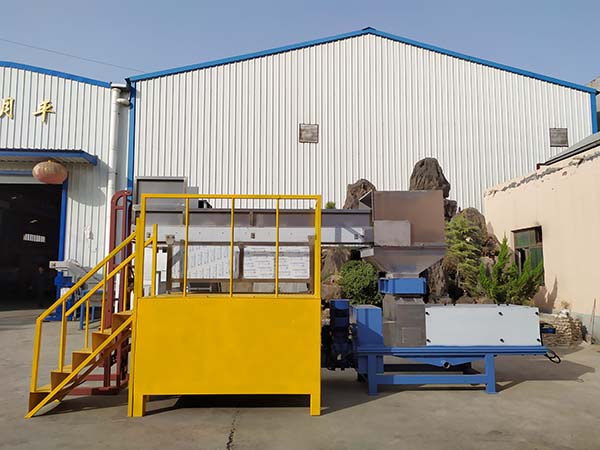
Two JMS-240 Colloid Mill Machines to Canada
10/03/2024
FR-280 Manure Dewatering Machine to Pakistan
10/09/2024
Two JMS-240 Colloid Mill Machines to Canada
10/03/2024
FR-280 Manure Dewatering Machine to Pakistan
10/09/2024Food waste dewatering machine plays a key role in kitchen waste management by effectively separating liquids from solids. This process significantly reduces the volume of food waste, making it easier for further handling, transportation, or disposal.
Applications of Food Waste Screw Press
Our food waste dewatering machine has found broad applications across various sectors:
-
Catering Industry: Restaurants and catering businesses generate large amounts of food waste daily. The screw press machine helps these businesses reduce waste volume, simplifying storage and lowering transportation costs for centralized waste management.
-
Residential Communities/Hospitals: In residential areas, hospitals, schools, or hotels where space for waste management is limited, dewatering machines reduce the volume of food waste, improving the efficiency of garbage collection and disposal.
-
Municipal Waste Treatment Centers: The screw press makes the kitchen waste treatment process more efficient. It separates the liquid from the solid components of food waste, significantly reducing its volume, thereby lowering transportation and landfill fees. In addition, the dewatered solid is less prone to odors, bacterial growth, and environmental contamination.

Kitchen Waste Dewatering System

Food Waste Screw Press
The byproducts of food waste dewatering, which mainly include solid residues and liquid extract, can be repurposed in various ways. The food waste, such as fruit/vegetable scraps, meat waste, eggshells, and bones, can be recycled into valuable resources like organic fertilizer.
Solid Residues
- Animal Feed: The solid residues often retain nutrients and can be used as animal feed.
- Composting and Fertilizer: Dewatered food waste can be composted into organic fertilizer.
- Biogas Production: The dewatered cake can be sent to anaerobic digesters for biogas production.
- Bedding Material: Some dewatered food waste solids, such as spent grains, can be used as bedding material for animals.
Liquid Extract
- Some liquid extract can be used as a nutrient-rich liquid fertilizer.
- The separated liquid is also used in anaerobic digesters to produce biogas, which can increase the yield of biogas plants.
- The solid and liquid can be further processed separately, which can improve the efficiency and reduce the environment impact.
Advantages of Dewatering Kitchen Waste
1. High-Efficiency Dewatering and Volume Reduction
The screw press mechanism effectively separates water from kitchen waste, reducing the moisture content of solids to 60%-70%. It reduces the volume of kitchen waste by over 50%, thereby lowering transportation and handling costs.
2. Resource Recovery
- Dewatered solids are easier to process further, enabling their use in composting, anaerobic digestion, or as animal feed.
- The separated liquid can be used for biogas fermentation to generate renewable energy.
3. Diverse Material Handling: The screw press efficiently processes high-moisture kitchen waste, including leftovers, vegetable peels, fish and meat scraps, and eggshells.
4. Odor Control: Dewatering mitigates fermentation-related odors, improving sanitation during waste storage and transportation.
5. Environmental Benefits: By separating solids and liquids, it will lower environmental contamination from leachate.
Working Principle of Food Waste Dewatering System
At Furui Machinery, we provide a comprehensive food waste dewatering system. The key equipment includes feeding and discharging conveyors, a food waste crusher, and a screw press machine. Below is a step-by-step overview of the process:
1. Feeding:
Food waste is fed into the screw press. To enhance efficiency, we offer a conveyor belt for automated feeding. Before this, a sorting platform is used to remove large, non-organic materials such as plastic and metal.
2. Crushing:
The food waste is then crushed into smaller pieces to facilitate efficient dewatering.
3. Screw Press Dewatering:
Within the screw press, a rotating screw moves the crushed food waste forward. As the materials move, the space between the screw and the screen gradually narrows. This decreasing volume compresses the material, squeezing the liquid out. The solid residues are then transported and discharged from the end of the machine.
Conclusion
The primary advantage of food waste dewatering machines is the reduction in waste volume. By reducing the volume of waste, you can save costs on storage, transportation, and disposal.
In addition to the screw press machine, Furui Machinery also offers oil water separators, and biological fermentation system for food waste treatment. The integrated system can achieve a waste volume reduction of about 80%. More than that, we provide customized solutions to better meet your specific requirements. Welcome to contact us for more details!

